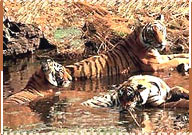

Think of Rajasthan and all that comes to mind are the images of forts, palaces, lakes, colourful festivals and the mighty Thar Desert. But the state of Rajasthan is not only the Thar Desert. The topography of Rajasthan ranges from the barren desert, scrub-thorn arid forests, rocks and ravines to wetlands and lush, green forests. Each of these areas is a haven for a wide spectrum of wildlife, bestowing the state with some of the most fascinating wildlife sanctuaries in India.
Rajasthan boasts of three national parks and over a dozen sanctuaries. Most of these areas are open to visitors round the year but are closed briefly during the monsoon. The wildlife sanctuaries in Rajasthan offer some of the best wildlife tours in India and can be explored either by jeep or on elephant back. For those looking for adventure, these wildlife sanctuaries of Rajasthan provide the kind of excitement that really makes the adrenaline flow.
Ranthambhor National Park: Located near the outer fringes of the Thar Desert and surrounded by the Vindhya and Aravali hill ranges, Ranthambhor National Park is Rajasthan's most well known tiger reserve under Project Tiger. Home to an exotic variety of animals in is 392 sq km area, one can spot sambhar, cheetal, wild boar, leopard, sloth bear, jackal, hyena among others. Wildlife safaris in Ranthambore offers the best of flora and fauna of the desert land as well as plain area near the hills. More...
Keoladeo Ghana National Park: An ornithologists' delight, Keoladeo Ghana National Park, popularly known as Bharatpur Bird Sanctuary was declared a National Park in 1983. This 29 sq km park is one of the world's greatest heronries. Its shallow, fresh water marsh attracts thousands of migratory birds. Over 10,000 nests of egrets, darters, cormorants, grey herons and storks hatch nearly 20,000 to 30,000 chicks every year. There is an infinite variety of migratory birds. Mammals like the sambhar, blackbuck, chital, nilgai, fishing cat, otter and mongoose also roam freely here. Best time to travel to Bharatpur is August to February. More...
Sariska Tiger Reserve: With the Aravali Hills in the backdrop, Sariska Tiger Reserve is other tigerland in Rajasthan which was brought under Project Tiger in 1979. Other than leopard, sambhar, nilgai, wild dog, and chinkara, the ruins of 9th and 10th century temples exist here. Best time to travel to Sariska is November to June. More...
Bhensrod Garh Sanctuary: A fairly new sanctuary, it was established in 1983 and covers a total area of 229 sq km of scrub and dry deciduous forest. Leopards, chinkara, sloth bear can be spotted here if one is lucky. The best time to plan you safari in Bhensrod Garh Sanctuary is between October and May.
Darrah Sanctuary: Previously the hunting ground of the Kota Maharajas, this sanctuary was established in 1955 and covers an area of 266 sq km. This hilly sanctuary with its thick forests is worth a visit during your travel to Rajasthan. The animals here include wolf, sloth bear, chinkara and leopard. The best time for Darrah Sanctuary safari is between February and May.
Desert National Sanctuary: Established in 1980, it is a colossal park sprawling on 3162 sq km. It has shrubs and trees in addition to rolling sand dunes. The wildlife wealth here comprises fox, desert cat, hare, spiney tail uromastix and sand fish. Thousands of sparrows, imperial sand grouse, bustards, falcons and eagles migrate here during the winter. Best time to visit is September to March.
Jaisamand Sanctuary: Established in 1957,this sanctuary is located beside the man-made lake of the same name. Covering a total area of 160 sq km, it harbours sloth bear, leopard, chital, chinkara, wild boar and a number of birds. Some crocodiles and fish can also be spotted here. Best time to visit is between November and January.
Kumbhalgarh Sanctuary: The majestic Kumbhalgarh Fort overlooks the 578 sq km sanctuary. The Aravalis hills, which remain barren for most of the year, turn green rains and provide shelter to sloth bear, leopard, flying squirrel. It is also the only sanctuary where the Indian wolf is breeding successfully. Best time for tours here is March to May and September to November.
Mount Abu Sanctuary: The highest point of Aravalis, the Guru Shikhar, lies in this 289 sq km sanctuary. Established in 1960,this provides shelter to the common langaur, wild boar, sambhar and leopard. The grey jungle fowl can also be spotted here. Besides a number of flowering trees enhance the beauty of this place.
Other wildlife sanctuaries in Rajasthan include Sitamata, Darrah, Chambal, Tal Chapper, Jamwa Ramgarh, Kaila Devi, Van Vihar, Ramgarh, Shergarh, Todgarh-Rad and Jawahar Sagar.


